The Asia-Pacific art sector
North America, Southeast Asia, China, Australia, New Zealand, and the Pacific
Art from the Asia-Pacific region is vital and dynamic, reflecting a rich diversity of cultures, histories and creative practices. Spanning vast geographies and communities, the region’s art blends deep-rooted cultural traditions with contemporary innovation, offering unique perspectives on identity, social change and global interconnectedness. Artists from the Asia-Pacific have shaped a powerful visual language that engages with both local and international dialogues.
-
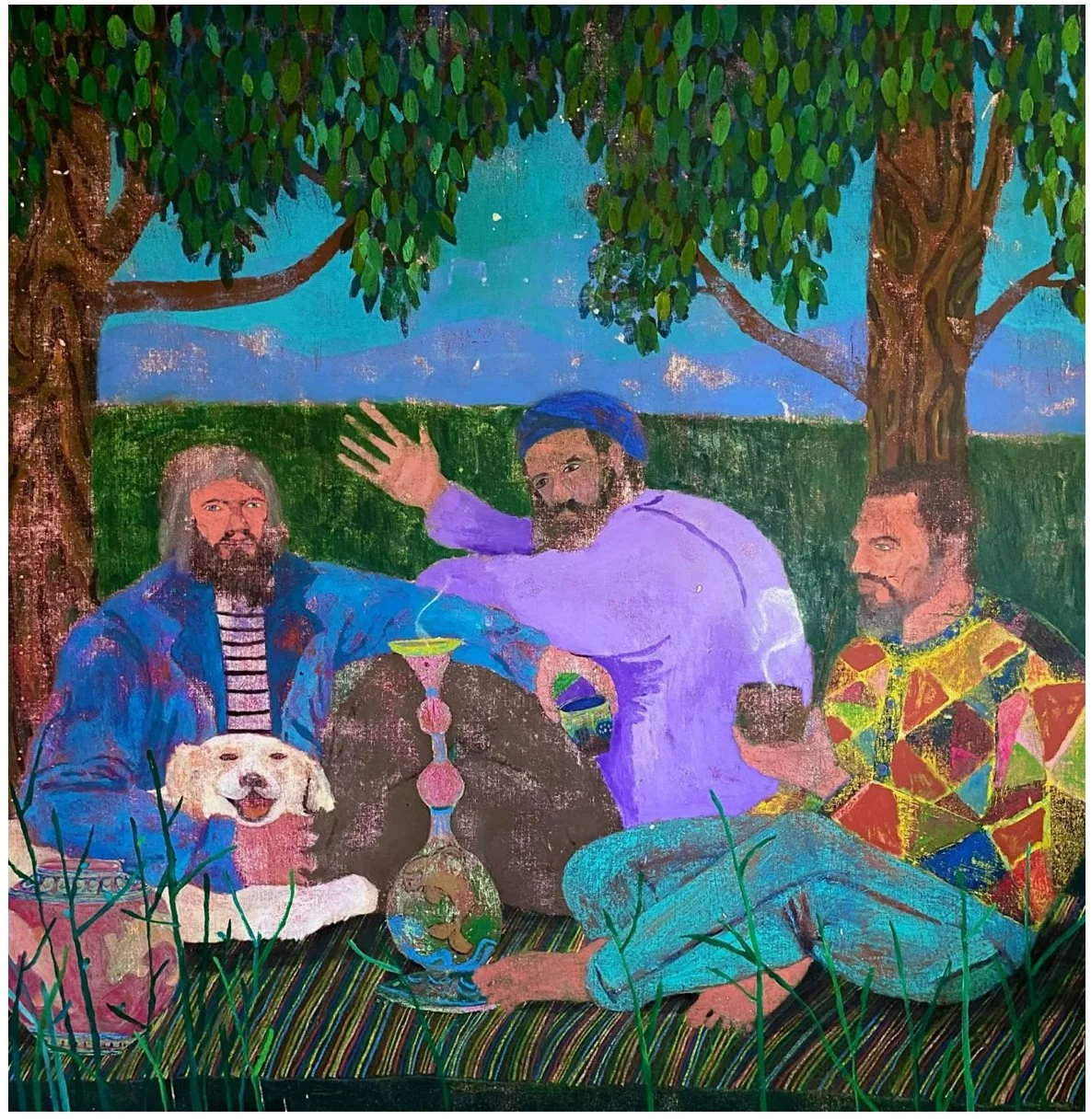
Australian art
Australian contemporary art represents an opportunity to engage with a vibrant, innovative, and evolving art scene that is increasingly recognised on the global stage. Contemporary Australia is a culturally diverse society, and its art reflects the diverse experiences and histories of its people, offering unique insights into the intersections of identity, culture, and migration.
Australian art engages with bold, diverse, and thought-provoking ideas featuring artists such as; Tracey Moffatt: As one of Australia’s most internationally acclaimed artists, Moffatt’s cinematic and narrative-driven photographs and films address identity, history, and storytelling. Ramesh Mario Nithiyendran: Known for his bold and provocative ceramic sculptures, Nithiyendran’s works challenge traditional forms. Brook Andrew: A multidisciplinary artist who reinterprets historical narratives through Indigenous perspectives, exploring social justice and cultural identity. Del Kathryn Barton: Known for her intricate and vividly detailed works celebrating femininity, nature, and the human form. Ricky Swallow: Swallow’s exceptional ability to transform everyday objects into meticulously constructed sculptures with profound conceptual depth citing 20th century modernism and craft make his work vital. Khaled Sabsabi: Sabsabi’s multimedia installations and video works explore cultural and spiritual identity, creating profound narratives within a global perspective. Richard Bell: A provocative voice in contemporary art, Bell’s works challenge colonial narratives and advocate for Indigenous rights, making them critical for socially engaged perspectives. Jordy Kerwick: Known for his bold, fantastical imagery, Kerwick’s paintings bring a fresh, international sensibility to contemporary Australian art. Josh Yeldham: Yeldham’s intricate mixed-media works explore spirituality and nature, offering a deep and evocative connection to the Australian landscape. Fiona Lowry: Lowry’s ethereal airbrushed paintings, often addressing the tension between beauty and darkness, are captivating. Dale Frank: Frank’s large-scale, glossy abstractions are visually striking and highly innovative, making his work an important part of experimental Australian art. Ben Quilty: Quilty’s visceral, emotionally charged paintings, often tackling social and political issues, solidify his place as one of Australia’s most influential contemporary artists. Julia Gutman: Gutman’s innovative textile-based works draw on personal memory and storytelling, making her a rising star in the Australian art scene. Daniel Boyd: Boyd’s conceptual reinterpretations of colonial history and cultural memory, often through his signature dot technique, make his works critical to exploring identity and history. Gordon Bennett: Bennett’s powerful critique of colonialism and identity through his multilayered, often politically charged works solidifies his importance as a global voice in contemporary art. Johnny Niesche: Renowned for his vibrant, minimalist paintings and installations, Niesche’s work adds a dynamic and meditative quality to any forum. Cressida Campbell: Campbell’s exquisite woodblock prints and paintings capture intimate, everyday scenes with extraordinary detail, making her works timeless recollections of place. Mitch Cairns: Cairns’ vibrant and surreal figurative works, often exploring personal and domestic themes, provide a fresh and innovative perspective in Australian painting. Justin Williams (above): Williams’ mystical, memory-laden paintings explore the intersections of nature, folklore, and the subconscious, making them compelling within narrative art. Mark Maurangi Carrol: Carrol’s intricate and evocative works merge contemporary abstraction with his Indigenous heritage, offering profound cultural insights. James Drinkwater: Drinkwater’s expressive and textural works, rich with narratives of place and memory, bring a raw and poetic energy. Karla Dickens: Dickens’ mixed-media works confront historical injustices and cultural resilience, making her art essential and focused on powerful storytelling. Lottie Consalvo: With deeply emotional and meditative abstract works, Consalvo’s art invites introspection, making her an important figure for exploring psychological and existential themes. Tim Storrier: Storrier’s atmospheric landscapes and symbolic imagery embody a unique vision of Australian identity. Ethel Spowers: A key figure in the modernist movement in Australia, Spowers’ innovative bold compositions and dynamic energy, are essential to highlight the evolution of Australian modern art.
-
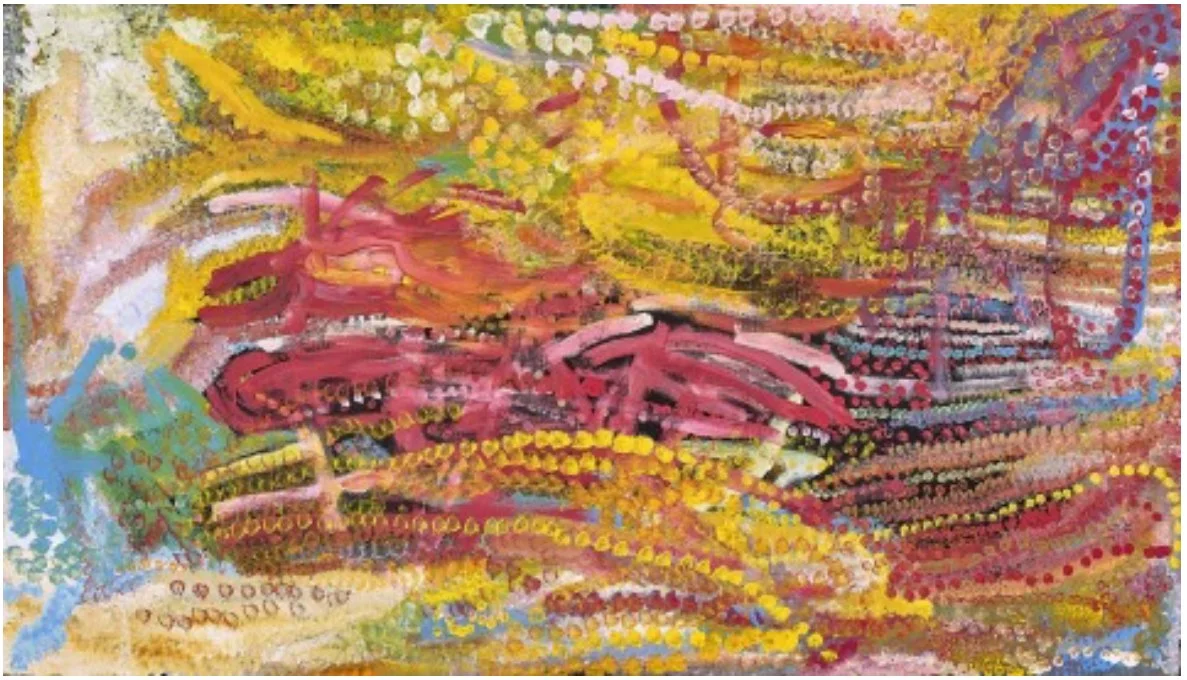
Australian Indigenous art
Australian Indigenous art is one of the oldest continuous art traditions in the world, reflecting over 65,000 years of cultural knowledge, storytelling, and spiritual connection to the land. Created by Aboriginal and Torres Strait Islander artists, it encompasses a diverse range of styles, mediums, and practices, from ancient rock engravings and bark paintings to contemporary works in acrylic, sculpture, and digital media. Indigenous art serves as a profound expression of cultural identity, transmitting stories of the Dreaming (creation stories), ancestral connections, deep ecological knowledge and urban experiences of colonisation. Renowned globally for its intricate patterns, vibrant colours, and symbolic depth, this art form transcends visual aesthetics, offering audiences a powerful glimpse into one of humanity’s most enduring and profound cultural heritages.
Aboriginal artists have had a profound impact on international art, modernism, and abstract art. Artists like Emily Kam Kngwarrey and Rover Thomas have redefined contemporary art by blending deeply rooted cultural traditions with modernist and abstract aesthetics, creating works of extraordinary complexity, beauty, and spiritual resonance. Their paintings, characterised by intricate patterns, vivid colour fields, and powerful symbolism, have drawn comparisons to the works of Western abstract pioneers, yet remain distinctly grounded in Indigenous storytelling and connection to Country. Emerging collectives like Tennant Creek Brio bring a raw, urban energy to this tradition, expanding its contemporary relevance. The strength of this art lies in its unique ability to bridge ancient cultural narratives with the universal language of abstraction, making it both visually compelling and culturally significant.
Emily Kngwarreye (above): A towering figure in Australian art, Kngwarreye’s groundbreaking abstract works, rooted in her deep cultural knowledge and connection to Country, exemplify the global significance of Indigenous visual language. Rover Thomas: Known for his minimalist landscapes and narrative-driven art, Thomas’s works are pivotal in bridging Indigenous storytelling with modernist aesthetics, revealing deep connections to land and culture. Warlimpirrnga Tjapaltjarri: Tjapaltjarri’s hypnotic and intricate desert paintings reflect sacred knowledge and ceremonial cycles, offering insight into the spiritual life of the Pintupi people. Tjumpo Tjapanangka: Tjapanangka’s bold, dynamic use of colour and storytelling through desert iconography reflects a powerful continuation of ancestral tradition through contemporary means. Ronnie Tjampitjinpa: A master of geometric abstraction, Tjampitjinpa’s work expresses the energy of ancestral stories with rhythmic, pulsating forms rooted in the Western Desert movement. Mick Namarari Tjapaltjarri: Renowned for his subtle and atmospheric representations of landscape and ceremony, Tjapaltjarri’s works embody a quiet elegance and a deep sense of cultural continuity. Tennant Creek Brio: This collective’s radical fusion of traditional practices with urban and graffiti-inspired aesthetics challenges conventional forms and expands the reach of Indigenous art into new cultural territories. Lin Onus: Onus’s innovative blending of Indigenous and Western artistic traditions offers complex, layered narratives of identity, place and environmental awareness. Vincent Namatjira: Renowned for his satirical and politically charged portraits, Namatjira’s works blend humour and critique to address history, power and postcolonial narratives. Kaylene Whiskey: Whiskey’s vibrant and playful narratives celebrate pop culture and Indigenous identity, combining comic-book aesthetics with community pride and cultural strength. Ken Thaiday: Thaiday’s intricately crafted headdresses and kinetic sculptures draw from Torres Strait Islander traditions, merging ceremony with contemporary materials and movement.
These artists, among many others, represent the strength, innovation, and ongoing evolution of Indigenous Australian art. Their practices honour ancestral knowledge while engaging with contemporary life, global issues, and new artistic languages. From sacred traditions to bold experimentation, Indigenous art continues to shape the cultural identity of Australia and assert its place within the global story of contemporary art.
-

Southeast Asian art
Southeast Asia has emerged as a vital and dynamic region in contemporary art, rich in cultural diversity, artistic experimentation, and interwoven histories. Spanning countries such as Indonesia, the Philippines, Singapore, Vietnam, Thailand, and Malaysia, the region’s artists engage with a wide range of themes, including folklore, spirituality, identity, memory, post-colonial narratives, and environmental concerns. Drawing on deep-rooted cultural traditions and lived experiences, their work reflects the complexities of their societies while connecting with global contemporary dialogues. Supported by a growing infrastructure of institutions, residencies, and exhibitions, Southeast Asia has become a significant voice in the international art landscape.
Artists such as Rodel Tapaya are celebrated for richly detailed paintings that merge traditional Filipino folklore with sharp contemporary commentary, creating expansive visual narratives grounded in cultural storytelling. Wedhar Riyadi explores the intersection of pop culture and heritage, fusing traditional Indonesian motifs with contemporary imagery to comment on identity in a globalised world. Tiffany Lafuente brings material experimentation and personal storytelling together in works rooted in contemporary Filipino culture, contributing to evolving expressions of Southeast Asian narrative art. Thalita Hamaoui is recognised for her introspective, textured works that explore memory, identity and the emotional weight of human experience. Rirkrit Tiravanija, based in Thailand, is known for socially engaged, participatory installations that blur the boundaries between art and everyday life, while Nguyen Phuong Linh from Vietnam examines displacement, memory, and transformation through poetic sculptural forms and installations. Martha Atienza, working in the Philippines, creates multimedia works that explore ecological fragility and social realities, while Christine Ay Tjoe from Indonesia employs abstraction to delve into psychological tension, spirituality, and the intricacies of human emotion.
Ayka Go produces intricate mixed-media pieces that reflect on impermanence, fragility and the layered processes of memory and repair, often working with a tactile and conceptual intensity. Thania Petersen uses performance, photography, and installation to investigate post-colonial legacies, cultural identity, and historical erasure, creating deeply resonant, multi-dimensional work. Heri Dono infuses his paintings and installations with political critique and humour, drawing from Javanese mythology and contemporary realities to create works that are both whimsical and sharply insightful. Christine Ay Tjoe’s emotionally charged abstractions are rooted in the complexities of spiritual struggle, internal conflict and personal transformation, expressing human vulnerability with striking visual form. Eko Nugroho blends street art, traditional batik, embroidery and graphic language to address social issues, resulting in vibrant, layered works that reflect the fast-paced shifts in Indonesian urban life. Maria Taniguchi is known for her meticulous brick wall paintings and conceptual installations, exploring repetition, labour and systems of meaning through minimalist forms. Ronald Ventura creates layered, hyper-detailed paintings and sculptures that reflect the collision of traditional Filipino symbolism with pop culture, fantasy, and global contemporary life.
These artists, along with many of their peers, represent the growing influence and diversity of Southeast Asian contemporary art. Their practices span a wide range of media and conceptual concerns, from intimate personal narratives to expansive socio-political critique. What unites their work is a shared urgency to reflect their environments, histories and identities in ways that are both deeply rooted and outward-looking.
The region’s cultural ecosystem is supported by a rapidly expanding network of museums, institutions, and arts infrastructure. Singapore has become a major cultural hub, with the National Gallery Singapore offering platforms for regional and international dialogue. In Indonesia, Museum MACAN plays a leading role in presenting Southeast Asian and global contemporary art. The BenCab Museum in the Philippines actively promotes both Indigenous and contemporary artistic practices. Across Malaysia, Thailand, Vietnam, and Cambodia, a new generation of curators, institutions and cultural workers are building frameworks that support sustained artistic development. As artists from Southeast Asia continue to exhibit in international biennales, triennales and global exhibitions, their voices and visions contribute powerfully to the evolving story of contemporary art worldwide.
-
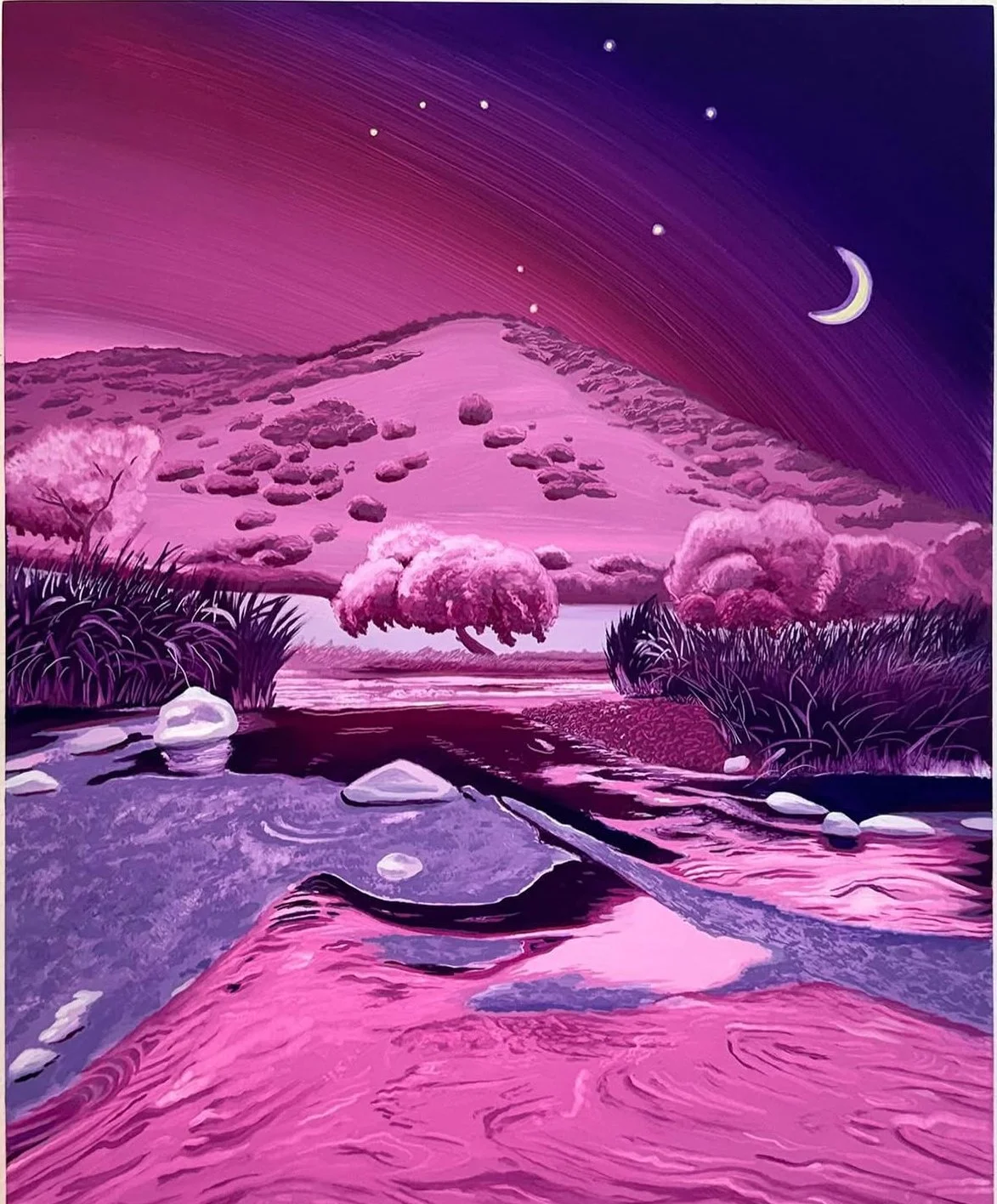
American art
American and international contemporary art continues to evolve through a broad spectrum of visual languages, conceptual approaches, and social narratives. Emerging and mid-career artists across the United States and beyond are pushing the boundaries of identity, materiality, abstraction, and representation, contributing to a rich and ever-expanding global art dialogue. Their practices engage with themes such as gender, race, memory, consumerism, environment, and diaspora, reflecting the complexity of lived experience in the 21st century. These artists are exhibiting widely in galleries, museums, biennales, and independent projects, earning recognition for their innovation, critical engagement, and artistic range.
Chloe Wise is known for her witty and satirical explorations of consumer culture and identity through mixed media and painting, creating a compelling critique of contemporary life. Jen Hitchings uses symbolic imagery and vivid colour to explore cycles of human experience, emotion, and the cosmos, producing visionary and layered compositions. Tschabalala Self creates vibrant, fabric-based portraits that explore themes of Black identity, femininity, and empowerment through an inventive fusion of textiles and paint. Lesley Vance approaches abstraction with a meticulous interplay of colour, light and form, producing fluid, dynamic works grounded in a refined visual language. Jordan Casteel is renowned for intimate, large-scale portraits that centre friends, family and community members, capturing everyday moments with empathy and depth. Shara Hughes challenges traditional landscapes through surreal compositions filled with colour and energy, offering psychological insight and painterly innovation. Amoako Boafo, working primarily in the U.S., creates luminous portraits that explore the Black diaspora with gestural brushwork and striking emotional presence. Jennifer Packer merges portraiture and still life with themes of memory and loss, presenting quiet, intimate compositions grounded in care and reflection. Simone Leigh focuses on Black womanhood, history, and bodily form through ceramic and sculptural works that honour resilience and shared memory. Devan Shimoyama blends glitter, fabric, and paint in works that explore Black queer identity, vulnerability, and celebration with rich surface texture and bold colour. Toyin Ojih Odutola produces narrative-driven, large-scale drawings exploring identity, lineage, and constructed histories through a distinctive graphic language. Dominique Fung draws from Asian art history, myth, and symbolism to construct surreal, poetic paintings that reimagine cultural narratives. Kennedy Yanko merges painting and sculpture using industrial metals and poured pigment, engaging with form, surface and the tension between fluidity and structure. Tomashi Jackson examines race, policy, and the built environment through layered, research-based paintings and mixed-media installations. Derrick Adams explores Black life, leisure and representation in vibrant works that span painting, sculpture, and performance. Oscar yi Hou creates vivid portraits that weave together themes of migration, cultural identity and queerness, drawing from his Chinese-American heritage and urban experience. Blair Saxon Hill works across collage and sculpture, using found materials to explore memory, fragmentation, and the passage of time through layered, experimental forms.
A number of more established American and international artists continue to shape the landscape of contemporary art with practices that span decades and mediums. Aly Helyer is known for her emotive, gestural portraits that delve into psychological states and the complexity of the human figure. Nicole Eisenman creates narrative-rich paintings and sculptures that combine humour, critique, and art historical reference to address contemporary social and political themes. Joe Bradley brings a raw, reductive approach to abstraction, challenging conventions of form and mark-making through a constantly evolving practice. Jonas Wood is celebrated for his bright, graphic interiors and still lifes that blend personal memory with flattened perspectives and stylised patterning. Lois Dodd, a pioneer of observational painting, captures quiet, everyday moments—landscapes, windows, and domestic views—with sensitivity and clarity. Andrew Cranston paints intimate, dreamlike scenes on found materials such as book covers, offering narrative fragments that blur memory and fiction. Albert Oehlen explores abstraction through digital and painterly techniques, creating dense, chaotic compositions that disrupt and reimagine the language of painting. David Ostrowski works with minimal gestures and unfinished surfaces, questioning authorship, perfection, and the role of failure in contemporary abstraction. Lucy Bull produces immersive, colour-rich abstractions that are deeply textural and emotionally resonant, inviting prolonged visual experience. Tom Anholt explores human mythology, narrative and interpersonal connection through jewel-toned, symbol-laden figurative works. Elizabeth Peyton is known for her intimate portraits of cultural figures and friends, painted with lyrical brushwork and emotional immediacy. Julie Mehretu creates large-scale, intricate abstractions that map geopolitical structures, collective memory, and urban landscapes with urgency and precision. Nicole Wittenberg uses bold colour and expressive line to capture scenes of intimacy, nature, and sensuality, navigating the space between figuration and abstraction. Jenna Gribbon investigates gaze, intimacy and the dynamics of personal relationships through lush, figurative paintings that are both provocative and tender.
Together, these artists reflect the evolving concerns, aesthetics and innovations of contemporary American and international art. Their practices span material experimentation, conceptual depth, and socially engaged themes, offering insight into the multifaceted world of contemporary visual culture. Through their work, they continue to expand the possibilities of painting, sculpture, installation and drawing, shaping the conversations and visual narratives of our time.
-
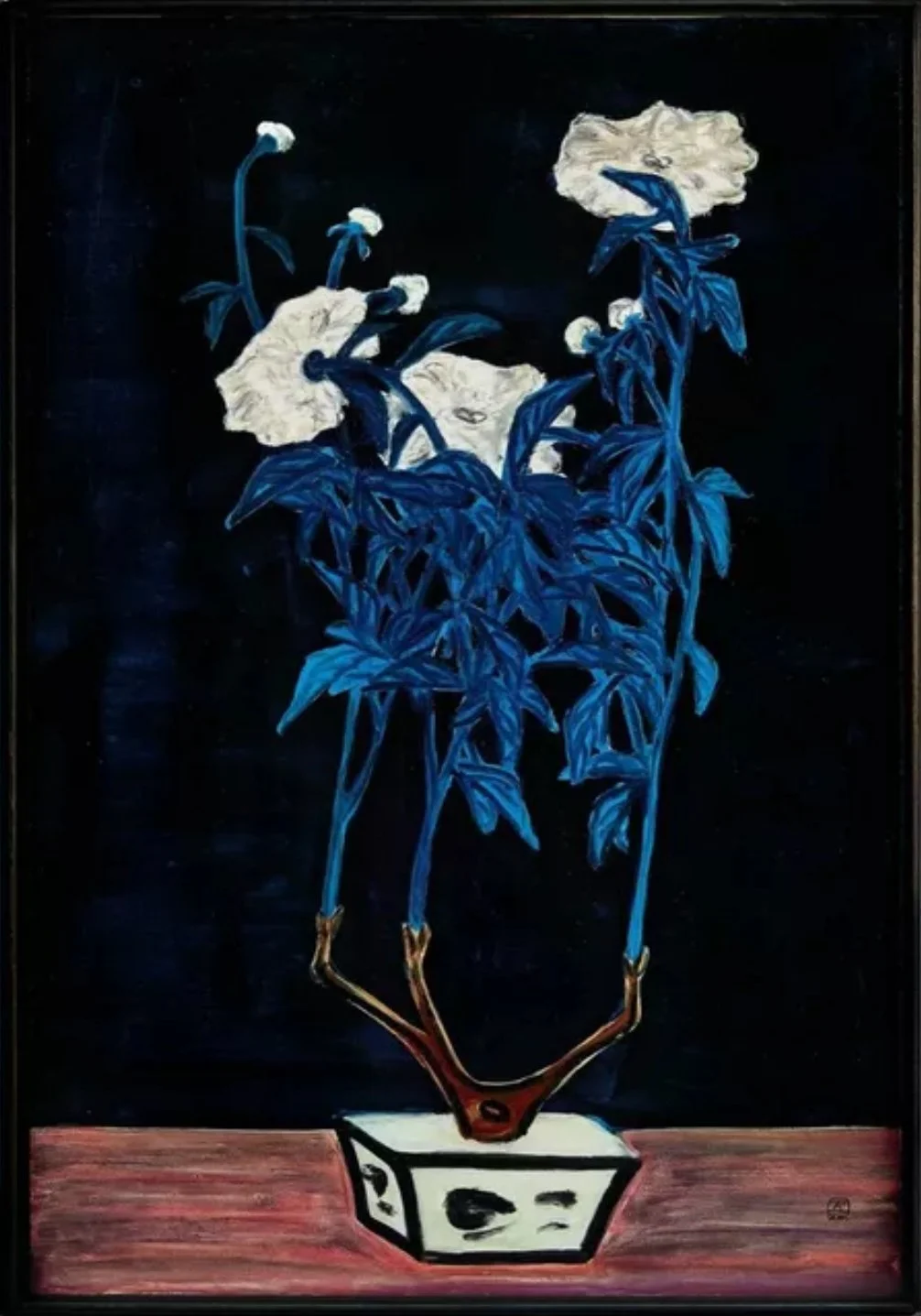
Chinese art
Chinese art spans one of the world’s most enduring and influential cultural legacies, encompassing over two millennia of creative practice. From ancient dynastic traditions to the cutting-edge experiments of the present day, it offers a profound visual narrative shaped by history, philosophy, politics, and social change. Chinese artists have drawn from traditional techniques while forging contemporary pathways, exploring themes such as identity, cultural memory, transformation, and the tensions between heritage and globalisation. Today, Chinese art plays a vital role in both national and international cultural landscapes, contributing to major exhibitions, biennales, and critical conversations about the future of contemporary art.
The emergence of Chinese contemporary art on the global stage was significantly shaped by the artistic movements of the 1980s and 1990s, particularly the New Wave and Cynical Realism. This period was pivotal, reflecting a cultural shift that paralleled the revolutionary moments of Western Impressionism and Modernism. Artists working during this time laid the foundations for today’s leading practices, responding to the complexities of a rapidly changing society through both critique and innovation. Among the most significant figures from this era is Yue Minjun, known for his iconic laughing self-portraits that blend humour and political satire, capturing a uniquely critical view of post-socialist China. Zhang Xiaogang created his renowned “Bloodline” series, drawing from family portraits and Socialist Realist aesthetics to explore memory, identity, and generational trauma. Fang Lijun produced surreal, unsettling depictions of bald figures that became visual metaphors for anxiety, individualism, and alienation in a time of cultural upheaval. Wang Guangyi examined the rise of consumerism and ideological shift in China through works such as his “Great Criticism” series, which juxtaposes propaganda imagery with Western commercial logos. Zeng Fanzhi, through emotionally charged portraits and abstracted forms, explored the psychological dimensions of urbanisation and social transformation, particularly in his acclaimed “Mask” series.
In the broader historical arc of modern Chinese art, several artists have emerged as central figures whose work bridges tradition and experimentation. Zao Wou-Ki developed lyrical abstractions that synthesised Chinese calligraphic gestures with Western modernist painting, establishing a new language of cross-cultural abstraction. Qi Baishi, a modern master of ink painting, captured poetic scenes of nature and everyday life with fluid brushwork and a profound sense of vitality. Zhang Daqian, known for his versatility, combined classical Chinese painting techniques with bold explorations of colour and form, creating both faithful homages and daring reinventions of traditional styles. Cui Ruzhuo is recognised for his monumental ink landscapes that continue the literati tradition, embodying a sense of continuity with classical ideals while embracing the scale and ambition of contemporary art. Chen Yifei brought cinematic realism and emotional resonance to his depictions of traditional life and cultural nostalgia. Fang Lijun and Yue Minjun, emerging from the Cynical Realism movement, continued to shape Chinese contemporary art through works that reflect societal tension, satire, and existential introspection. Liu Xiaodong focuses on real people and lived experience, often painting on location to create large-scale portraits that reflect China’s shifting social and environmental realities. Wu Guanzhong played a pivotal role in connecting Eastern and Western art forms, moving fluidly between abstraction and figuration, and combining modernist formalism with Chinese aesthetics. Sanyu, often called the “Chinese Matisse,” created sensual, minimalist works that merged Chinese brush traditions with Western compositional structures, contributing significantly to the development of modern Chinese painting.
The diversity and impact of Chinese contemporary artists is also reflected in research such as the Hurun China Art List, which identifies some of the most consistent and influential figures shaping the art landscape. Liu Ye, leading the list, is celebrated for his minimalistic and whimsical style, with works often featuring solitary figures and architectural elements rendered with calm precision and emotional resonance. Cui Ruzhuo, a prominent presence in the art world, is known for his large-scale ink works that evoke the grandeur of Chinese landscape painting, blending tradition and innovation. Huang Yuxing, a rising star, creates vibrant, psychedelic landscapes filled with futuristic symbolism and saturated colour, offering a younger voice in Chinese art that connects with global contemporary movements. Zhou Chunya continues to receive critical attention for his expressive use of colour and his exploration of symbolic themes such as masculinity, identity, and cultural transition. Zeng Fanzhi remains a defining figure, known for his mastery of emotional and psychological portraiture as well as his painterly experimentation.
Newer voices such as Jia Aili offer introspective, post-apocalyptic visions that combine technical virtuosity with metaphysical inquiry, addressing themes of modernity, loss, and the unknown. Liu Xiaodong, long recognised for his deeply observational practice, maintains a strong presence with works that blend documentary and painterly approaches. Artists who have maintained visibility for more than a decade, include; Cui Ruzhuo, Zhou Chunya, Zeng Fanzhi, Liu Ye, Fan Zeng, Huang Jiannan, Zhang Xiaogang, Liu Wei, He Jiaying, Liu Xiaodong, Shang Yang, Luo Zhongli, Jin Shangyi, Fang Lijun, Liu Guosong, Shi Guoliang, Wang Mingming, Ai Xuan, Ren Zhong, Wang Guangyi, Lin Yong, Jia Youfu, Wang Yidong, and Tian Liming. These artists represent a broad spectrum of practice—from literati painting and figuration to conceptual abstraction and socio-political commentary.
The legacy and continued innovation within Chinese art speak to the richness of its visual language and the multiplicity of its voices. Artists across generations contribute to a national and international discourse that bridges dynastic heritage, revolutionary experience, and contemporary realities. Their work reflects a deep awareness of cultural lineage while offering new perspectives on what it means to create in a rapidly changing world. Through painting, sculpture, ink, installation, photography, and performance, Chinese artists continue to shape how we understand history, identity, power, and beauty in the 21st century.
-
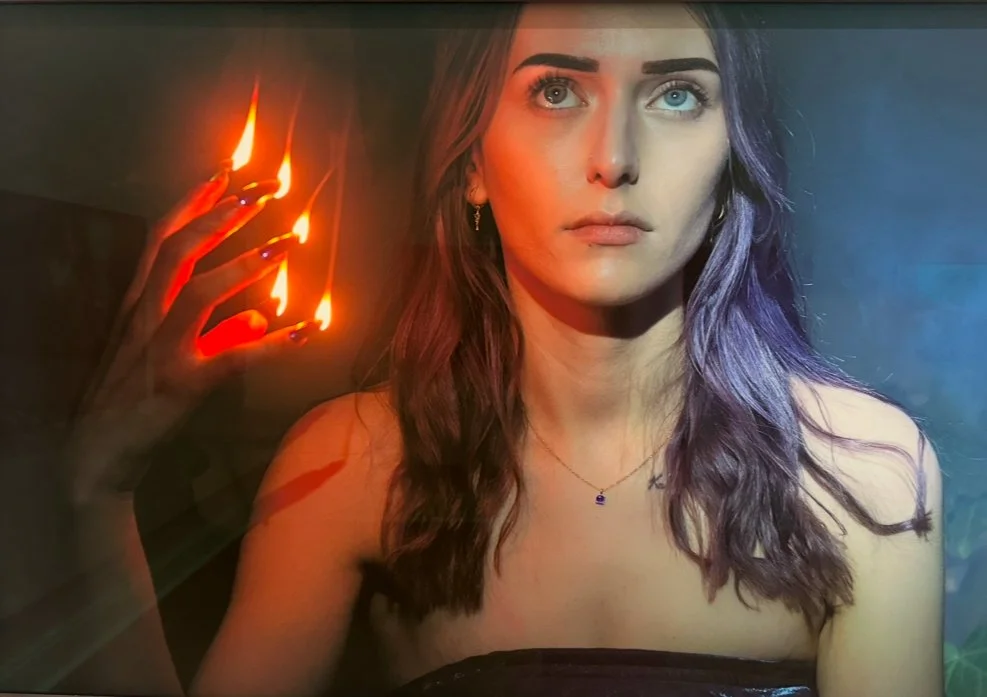
New Zealand and Pacific art
New Zealand contemporary art offers a dynamic and multifaceted perspective on the cultural and environmental narratives of the Asia-Pacific region, blending influences from Māori heritage, Pacific Island traditions, and global contemporary movements. Through innovative practices and powerful storytelling, New Zealand artists engage with themes such as identity, land, colonial history, and ecological concerns. The distinct perspectives of Māori artists in particular bring invaluable cultural depth, as their works often draw on whakapapa (genealogy), tūrangawaewae (place of standing), and kaitiakitanga (guardianship) to connect audiences to the land and its stories.
Leading New Zealand and Māori artists continue to gain recognition on the international stage, with their work being presented at art fairs, biennales, exhibitions, and institutional programs. Emerging voices such as Ayesha Green, Reuben Paterson, and the Māori collective Mata Aho bring new energy to the field, blending craft, installation, and storytelling. Their work incorporates traditional materials, cultural knowledge, and contemporary issues, creating large-scale, collaborative, and conceptually ambitious artworks that challenge perceptions of Indigenous practice.
Established artists such as Ralph Hotere are known for minimalist and politically charged works that reflect on themes of identity, resistance, and Indigenous sovereignty. Lisa Reihana creates immersive multimedia installations, such as the critically acclaimed In Pursuit of Venus [infected], which reimagines colonial encounters and challenges historical representations through innovative digital art. Gordon Walters, one of New Zealand’s most iconic modernists, is recognised for his koru-based abstractions that bridge Māori visual culture and international modernist aesthetics. Yuki Kihara, a pioneering Samoan-Japanese artist, critically examines post-colonial identity, gender, and cultural politics through photography and performance, including her historic representation of New Zealand at the Venice Biennale. Michael Parekowhai produces large-scale sculptural and installation works that explore memory, national identity, and cross-cultural exchange with wit, intelligence, and emotional resonance.
Bill Hammond is known for his surreal and haunting paintings populated with bird-like figures, which serve as allegories for colonisation, extinction, and ecological imbalance in Aotearoa. Frances Hodgkins, a major figure in early modernism, developed a vibrant and expressive style that connected New Zealand’s art history with broader international movements. Shane Cotton combines Māori iconography with Western visual languages to explore histories of conflict, spiritual duality, and contemporary Indigenous identity. Judy Darragh challenges traditional notions of material and value through installations that use found objects, vivid colours, and unexpected juxtapositions. Lonnie Hutchinson is celebrated for her intricate black cut-paper works and installations that explore femininity, urban space, and Māori whakapapa. Tia Ranginui, a leading contemporary Māori photographer, creates intimate and evocative works that explore Māori identity, familial connections, and cultural heritage through lens-based storytelling.
Contemporary Pacific art, encompassing Samoa, Tonga, Papua New Guinea, Fiji, Solomon Islands, the Cook Islands, and other nations, is also experiencing growing recognition for its unique fusion of traditional knowledge and contemporary expression. Artists from the region are drawing attention to ancestral legacies, climate change, gender identity, and post-colonial narratives. Their practices often integrate customary materials such as tapa, masi, and natural pigments with digital media, installation, painting, and performance.
Yuki Kihara, in addition to her work within New Zealand’s art scene, represents a broader Pacific voice through works that critique colonialism and challenge binaries of gender and cultural identity. Jeffry Feeger, from Papua New Guinea, creates vibrant contemporary portraits rooted in local tradition and community representation. Joana Monolagi, a Fijian artist, works with masi (bark cloth) to express cultural heritage, gender roles, and ecological themes through a deeply personal and ceremonial lens. Vaimaila Urale, a Tongan artist, explores cultural identity, technology, and language through mark-making and experimental digital forms. Angela Tiatia, from the Solomon Islands, creates performance, video, and installation works that address the fragility of Pacific nations in the face of climate change, colonisation, and gender inequality. These artists exemplify a shift in contemporary practice that embraces traditional knowledge while forging new narratives on identity, place, and sustainability.
Nineteenth- and twentieth-century Pacific art and artefacts hold a crucial place in understanding the long histories of cultural expression across the region. These works, including intricately carved masks, tapa cloths, ceremonial adornments, and woven textiles, reflect spiritual belief systems, social structures, and the deep relationship between people, land, and the sea. They were used in rites of passage, spiritual ceremonies, conflict, and storytelling, forming a visual language of great complexity and sophistication.
These historical works remain foundational to understanding the development of contemporary Pacific art, offering continuity between past and present. They provide insight into the resilience and adaptability of Pacific communities as they responded to changing political, environmental, and social circumstances. When presented with appropriate cultural and geographic context, these artworks reveal a profound engagement with the spiritual, material, and ecological worlds of the Pacific. Their presence in global museum collections and public exhibitions today affirms their lasting significance, not just as artefacts of the past, but as living testaments to cultural endurance and creative innovation.
Together, the work of New Zealand and Pacific artists contributes to a powerful visual and cultural narrative that reflects shared histories, evolving identities, and future-facing practices. Whether through digital innovation, material experimentation, or the revival of customary forms, artists from this region continue to shape how audiences understand Indigenous knowledge, environmental justice, and cultural sovereignty in the contemporary world.